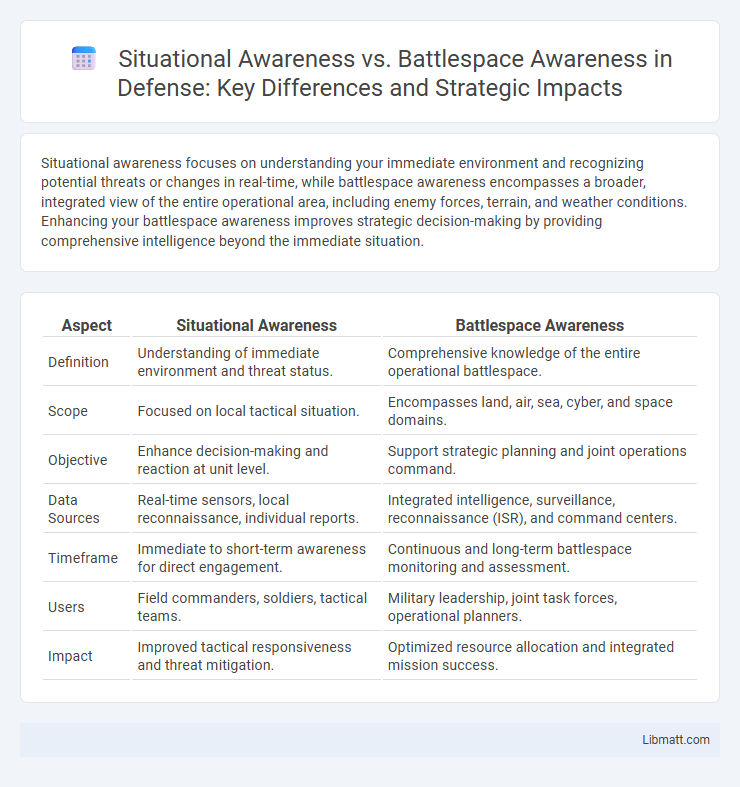Situational awareness focuses on understanding your immediate environment and recognizing potential threats or changes in real-time, while battlespace awareness encompasses a broader, integrated view of the entire operational area, including enemy forces, terrain, and weather conditions. Enhancing your battlespace awareness improves strategic decision-making by providing comprehensive intelligence beyond the immediate situation.
Table of Comparison
| Aspect | Situational Awareness | Battlespace Awareness |
|---|---|---|
| Definition | Understanding of immediate environment and threat status. | Comprehensive knowledge of the entire operational battlespace. |
| Scope | Focused on local tactical situation. | Encompasses land, air, sea, cyber, and space domains. |
| Objective | Enhance decision-making and reaction at unit level. | Support strategic planning and joint operations command. |
| Data Sources | Real-time sensors, local reconnaissance, individual reports. | Integrated intelligence, surveillance, reconnaissance (ISR), and command centers. |
| Timeframe | Immediate to short-term awareness for direct engagement. | Continuous and long-term battlespace monitoring and assessment. |
| Users | Field commanders, soldiers, tactical teams. | Military leadership, joint task forces, operational planners. |
| Impact | Improved tactical responsiveness and threat mitigation. | Optimized resource allocation and integrated mission success. |
Introduction to Situational Awareness
Situational awareness involves perceiving, comprehending, and projecting the status of the environment and elements within it to make informed decisions. Battlespace awareness expands this concept by integrating real-time intelligence, surveillance, and reconnaissance data across multiple domains to provide a comprehensive operational picture. This enables military forces to anticipate threats, coordinate actions, and achieve strategic objectives effectively.
Defining Battlespace Awareness
Battlespace awareness refers to the comprehensive understanding of all factors within a military operational environment, including terrain, weather, enemy forces, and civilian activities. It integrates real-time data from intelligence, surveillance, reconnaissance (ISR) systems, and communication networks to create a unified operational picture. This holistic situational insight enables commanders to make informed decisions, coordinate assets, and anticipate threats effectively across air, land, sea, cyber, and space domains.
Key Differences Between Situational and Battlespace Awareness
Situational awareness refers to your understanding of the immediate environment, including the recognition of threats, opportunities, and changes within a localized context. Battlespace awareness expands this concept to a wider operational domain, integrating data from multiple sources like intelligence, surveillance, and reconnaissance to provide a comprehensive picture of the battlefield. Key differences lie in their scope and scale: situational awareness focuses on real-time, local conditions, while battlespace awareness encompasses a broader, strategic view essential for coordinated military operations.
Importance of Situational Awareness in Modern Operations
Situational awareness is crucial in modern operations as it enables real-time understanding of dynamic environments, helping personnel anticipate threats and make informed decisions. Unlike battlespace awareness, which encompasses broader intelligence and operational data across multiple domains, situational awareness focuses on immediate, localized perception to enhance tactical responsiveness. Your ability to maintain high situational awareness directly impacts mission success and the safety of forces in complex, fast-changing scenarios.
The Role of Technology in Battlespace Awareness
Technology plays a critical role in enhancing battlespace awareness by integrating real-time data from a variety of sources such as satellites, drones, and sensors to provide commanders with a comprehensive operational picture. Unlike situational awareness, which is often localized and immediate, battlespace awareness encompasses a broader strategic context, leveraging advanced analytics, artificial intelligence, and communication networks to predict threats and coordinate forces effectively. Your ability to make informed decisions in dynamic combat environments is amplified through these technological advancements, ensuring superior command and control capabilities.
Human Factors in Situational Awareness
Human factors in situational awareness emphasize the cognitive processes, perception, and decision-making abilities of individuals operating within complex environments, directly influencing their effectiveness in recognizing threats and opportunities. Battlespace awareness expands this concept by integrating multiple data sources, technological inputs, and intelligence to provide a comprehensive operational picture, yet it still depends heavily on human operators to interpret and act on this information accurately. Understanding human limitations such as attention span, stress, and fatigue is crucial to optimizing situational awareness and enhancing overall battlespace effectiveness.
Integrating Situational and Battlespace Awareness
Integrating situational awareness with battlespace awareness enhances real-time decision-making by combining granular, localized data with a broader operational perspective. This integration leverages advanced sensor fusion, communication networks, and AI-driven analytics to provide comprehensive intelligence across multiple domains. Your ability to synchronize these awareness layers improves threat detection, resource allocation, and mission success in complex combat environments.
Real-World Applications and Case Studies
Situational awareness involves understanding immediate events and surroundings, crucial for first responders managing emergencies like natural disasters or traffic incidents. Battlespace awareness extends this concept by integrating real-time intelligence, surveillance, and reconnaissance data, enabling military commanders to make strategic decisions during combat operations, as demonstrated in modern conflicts such as the Gulf War and Afghanistan campaigns. Your ability to leverage these awareness types improves decision-making and operational effectiveness in both civilian and military contexts.
Challenges in Achieving Comprehensive Awareness
Achieving comprehensive situational awareness faces challenges like data overload, sensor integration difficulties, and real-time information processing constraints. Battlespace awareness adds complexity by requiring fusion of multi-domain intelligence, encompassing land, air, sea, cyber, and space environments. Effective decision-making depends on overcoming latency issues, asymmetric threat detection, and maintaining secure communication networks across diverse and dynamic operational theaters.
Future Trends in Situational and Battlespace Awareness
Future trends in situational and battlespace awareness emphasize integration of artificial intelligence, real-time data fusion, and enhanced sensor networks to improve decision-making and operational efficiency. Advanced technologies like machine learning and autonomous systems will enable predictive analytics, providing You with proactive threat identification and adaptive response capabilities. Enhanced interoperability between diverse platforms and seamless communication across multi-domain environments will define the next generation of battlespace and situational awareness.
Situational awareness vs Battlespace awareness Infographic

 libmatt.com
libmatt.com